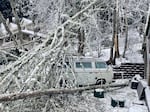In the aftermath of major ice storms that pummeled much of northwest Oregon, many homeowners are dealing with property damages. Here are some tips for folks considering filing an insurance claim.
When first assessing damage to home or property, safety is paramount.

If a tree falls on your car and also hits your home, that’s two different policies. Damage to a structure is under homeowner’s insurance while vehicle damage is under comprehensive auto coverage.
Tiffany Eckert / KLCC
“If you cannot safely remove something without causing more damage — don’t do it,” said Jason Horton with the Division of Financial Regulation. That’s a part of the Oregon Department of Consumer and Business Services that makes sure insurance companies follow the law.
Horton said losses from ice, wind, tree falls or flooding should first prompt a call to your insurance agent or company. Take pictures and make detailed lists of damaged property, including brand names and model numbers. Horton said homeowners should protect property from further damage but not make permanent repairs until an insurer inspects it.
And know your deductibles: Horton advises a cost/benefit analysis can help determine if a reported claim is worth it. “You know, (if) you file a claim and your insurance pays out — it could impact your rates. As in, they’ll go up,” he said.
DFR consumer advocates are available to help with problems or concerns with insurance claims. For assistance, consumers can call 1-888-877-4894 or email dfr.insurancehelp@dcbs.oregon.gov.
Here is additional information from Oregon’s Division of Financial Regulation:
Homeowners insurance
A typical homeowners policy covers damage to the home caused by falling trees or limbs and weight of ice and snow.
For example, if your home sustained severe structural damage from a fallen tree or other storm debris, and it is deemed uninhabitable, you may qualify for additional living expenses, which helps cover the extra costs of lodging, meals, and even pet boarding while you are unable to live in the home.
If your home received minor damage, such as the wind blowing a few shingles off your house, your homeowners insurance will probably replace the damaged shingles, but not the entire roof.
Winter storms can also create sudden damage caused by an ice dam on the roof or pipes bursting due to freezing. This type of damage is typically covered and can be extensive if a pipe burst floods a home or minor, such as a leak from an ice dam causing a stain on a ceiling.
Coverage may be available for food spoilage due to the power outage. However, be sure to consider if the actual benefit from filing this type of claim is worth the potential effect it can have on your premium. Remember, if the loss is close to or less than your deductible you may not want to file a claim. If you need to file a claim for another type of damage to your home, food spoilage can typically be added to the claim you need to file for repairs.
Auto
There are three coverage options on an auto insurance policy that typically apply to winter storms.
- Comprehensive covers damage caused by falling trees or limbs. This includes while your car is parked inside a garage.
- Collision covers damage to your car that occurs while driving. This includes hitting storm debris or sliding on ice.
- Liability covers damage you accidentally caused to another person’s property or to a person who is injured in an accident.